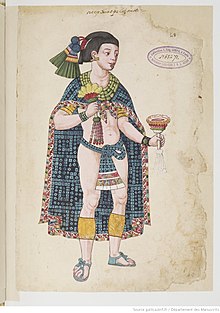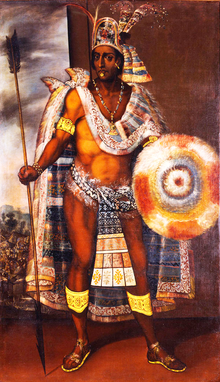
| Tlahtoāni of Aztec Empire | |
|---|---|
 Sacred war emblem Sacred war emblem | |
| Details | |
| Style | Huēyi tlahtoāni |
| First monarch | Acamapichtli |
| Last monarch | Cuauhtémoc |
| Formation | c. 1376 |
| Abolition | 1521 |
| Residence | Tenochtitlan |
| Appointer | Council of Elders |
Tlahtoāni (Classical Nahuatl: tlahtoāni pronounced [t͡ɬaʔtoˈaːniˀ] , "ruler, sovereign"; plural tlahtohqueh [t͡ɬaʔˈtoʔkeʔ]) is a historical title used by the dynastic rulers of āltepēmeh (singular āltepētl, often translated into English as "city-state"), autonomous political entities formed by many pre-Columbian Nahuatl-speaking peoples in the Valley of Mexico during the Postclassic Period. The title of huēyi tlahtoāni [es] ([ˈweːjiˀ t͡ɬaʔtoˈaːniˀ], "great ruler, emperor") was used by the rulers of the Aztec Empire, an alliance between the āltepēmeh of Tenochtitlan, Tetzcoco, and Tlacopan.
Each āltepētl had its own tlahtoāni who would concurrently function as its ruler, high priest and commander-in-chief. The tlahtoāni wielded ultimate authority over all land within the āltepētl, overseeing tribute collection, market activities, temple affairs, and the resolution of judicial disputes. Typically a dynastic ruler hailing from the royal lineage, the tlahtoāni served for life. However, in certain instances, a council of nobles, elders, and priests could elect a tlahtoāni from a pool of four candidates.
Etymology
The term tlahtoāni ([t͡ɬaʔtoˈaːniˀ]) is an agent noun derived from the verb tlahtoa, meaning "to speak", thereby carrying the literal meaning of "one who speaks". In English, it has been translated variously as "king", "sovereign", "ruler" or, based on its etymology, "speaker". It takes the plural form tlahtohqueh ([t͡ɬaʔˈtoʔkeʔ]), and the construct form *tlahtohcā-, as in tlahtohcāyōtl ("rulership, realm"), tlahtohcātlālli ("royal lands"), and tlahtohcācalli ("royal palace").
Related titles include tlahtohcāpilli ([t͡ɬaʔtoʔkaːˈpilːiˀ]), given to princes and other prominent noblemen, and cihuātlahtoāni ([siwaːt͡ɬaʔtoˈaːniˀ]), used to designate noblewomen including consorts or princesses.
Commanding hierarchy
The cihuācōātl was the second in command after the tlahtoāni, was a member of the nobility, served as the supreme judge for the court system, appointed all lower court judges, and handled the financial affairs of the āltepētl.
Tlahtoāni during times of war
During times of war, the tlahtoāni would be in charge of creating battle plans, and making strategies for his army. He would draft these plans after receiving information from various scouts, messengers, and spies who were sent out to an enemy āltepētl (city-state). Detailed information was presented to him from those reports to be able to construct a layout of the enemy. This was essential because this ensured the safety and success of each battle.
These layouts would be heavily detailed from city structures to surrounding area. The tlahtoāni would be the most informed about any conflict and would be the primary decision maker during war.
He would also be in charge of gaining support from allied rulers by sending gifts and emissaries from his city-state. During warfare the tlahtoāni would be informed immediately of deaths and captures of his warriors. He would also be in charge of informing his citizens about fallen or captive warriors, and would present gifts to the successful ones.
Tlahtohqueh of Tenochtitlan

There were eleven tlahtohqueh of Tenochtitlan. Beginning with Itzcoatl, the tlahtoāni of Tenochtitlan was also the huēyi tlahtoāni of the Aztec Empire.
- Acamapichtli: 1376–1395
- Huitzilihuitl: 1395–1417
- Chimalpopoca: 1417–1427
- Itzcoatl: 1427–1440
- Moctezuma I: 1440–1469
- Axayacatl: 1469–1481
- Tizoc: 1481–1486
- Ahuitzotl: 1486–1502
- Moctezuma II: 1502–1520
- Cuitláhuac: 1520
- Cuauhtémoc: 1520–1521
See also
References
- The term is commonly spelled tlatoani, as frequently utilized in historical Spanish and Nahuatl documents from the colonial period, as well as in contemporary Spanish usage, whence the term came into English.
- Frequently spelled tlatoque, omitting the indication of the saltillo (glottal stop), represented by the letter ⟨h⟩ in certain contemporary sources and modern academic references.
- Lockhart (2001, p.238); Schroeder (2007, p.3), who pre. See also the entry for "TLAHTOANI" Archived 2007-06-14 at the Wayback Machine, in Wimmer (2006)
- ^ "Aztec Political Structure". Tarlton Law Library. Retrieved 10 March 2020.
- "pre-Columbian civilizations". Encyclopædia Britannica. 2016-11-22. Retrieved 2017-05-22.
- Nahuatl dictionary (1997). Wired humanities project. Retrieved January 1, 2012, from link
- Schroeder (2007, pp.3–4). See also the entry for "CIHUATLAHTOANI" Archived 2007-06-08 at the Wayback Machine in Wimmer (2006)
- "Aztec and Maya Law". Tarlton Law Library. Retrieved 11 March 2020.
Sources
- Berdan, Frances F.; Richard E. Blanton; Elizabeth Hill Boone; Mary G. Hodge; Michael E. Smith; Emily Umberger (1996). Aztec Imperial Strategies. Washington, DC: Dumbarton Oaks Research Library and Collection. ISBN 0-88402-211-0. OCLC 27035231.
- Gibson, Charles (1964). The Aztecs Under Spanish Rule: A History of the Indians of the Valley of Mexico, 1519–1810 (Reprinted 1976 ed.). Stanford, CA: Stanford University Press. ISBN 0-8047-0196-2. OCLC 190295.
- Lockhart, James (2001). Nahuatl as Written: Lessons in Older Written Nahuatl, with Copious Examples and Texts. UCLA Latin American studies, vol. 88; Nahuatl studies series, no. 6. Stanford and Los Angeles: Stanford University Press and UCLA Latin American Center Publications. ISBN 0-8047-4282-0. OCLC 46858459. (in English and Nahuatl languages)
- Schroeder, Susan (1991). Chimalpahin and the Kingdoms of Chalco. Tucson: University of Arizona Press. ISBN 0-8165-1182-9. OCLC 21976206.
- Schroeder, Susan (2007). "The Annals of Chimalpahin" (PDF). In James Lockhart; Lisa Sousa; Stephanie Wood (eds.). Sources and Methods for the Study of Postconquest Mesoamerican Ethnohistory (PDF e-book online publication) (Provisional version ed.). Eugene: University of Oregon Wired Humanities Project. Retrieved 2008-05-16.
- Wimmer, Alexis (2006). "Dictionnaire de la langue nahuatl classique" (online version, incorporating reproductions from Dictionnaire de la langue nahuatl ou mexicaine , by Rémi Siméon). (in French and Nahuatl languages)
Further reading
- Carrasco, David. Daily Life of The Aztecs: People of the Sun and Earth. Connecticut: Greenwood Press, 1998.
- Sahagun, Bernardino de. Florentine Codex: General History of the Things of New Spain. Translated and edited by Arthur J. O. Anderson and Charles E. Dibble. 13 vols. Santa Fe: School of American Research, and University of Utah, 1950–1982.
- Somervill, Barbara A. Great Empires of the Past: Empire of the Aztecs. New York: Chelsa House, 2010.